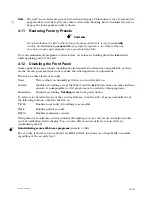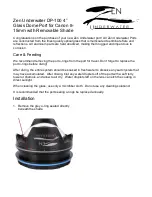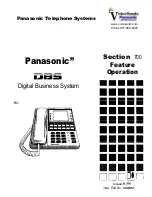
4-5
Rev 2.2, 10/31/94
N
R
Switch
Toggles the NR between active and
out
. When
active, the
F
REQ
and
T
HRESH
switches are active.
When editing, the
NR
switch LED flashes,
otherwise it reflects the state of the NR (in or out).
Whenever NR is currently being edited, the output
headroom LED display changes to indicate
gain-reduction.
F
REQ
Switch
Sets the resting frequency of the NR (the -3 dB
point of the dynamic lowpass filter when there is
no input signal).
T
HRESHOLD
Switch
The NR uses two threshold settings, one relative
(display reads
r
), and the other absolute (the
display reads
A
). You access the two threshold
settings by pressing the
T
HRESH
switch when the
NR has been selected. The NR reacts to the ratio of
the signal passing through the adaptive lowpass
filter and the signal being rejected by the adaptive
lowpass filter. Higher (less negative) relative
threshold settings require larger amounts of high-
frequency content to cause the filter to 'open up.'
The absolute threshold setting determines the
transition point below which the NR system ignores
the high-frequency content and relies strictly upon
signal level information. Typically the absolute
threshold should be set to equal the noise floor of
the program material; the useful range for this
parameter being from -80 to -50 dB.
4.5.2 De-Esser Block
Like the NR system, the de-esser is a feedback control system. The de-esser uses a broadband
limiter with a peaked highpass filter in its sidechain; the frequency response is always flat
regardless of the degree of de-essing. The attack, release, and frequency switches are functional
and these parameters are also accessible via MIDI or the realtime editor.
DS
Switch
Toggles the de-esser between active and
out
. When
editing, the de-esser switch LED flashes, otherwise
it reflects the state of the de-esser (in or out).
Whenever editing the de-esser parameters, the
output LED display changes to read
gain-reduction.
T
HRESHOLD
Switch
Sets the relative threshold for the start of de-ess
action. The de-esser measures the energy on each
side (highpass and lowpass) of the sidechain filter.
Sibilant sounds above this threshold level are
reduced in level. The absolute threshold (adjustable
via the realtime editor) sets a minimum level that
the signal must exceed to receive de-essing.(see
Appendix A).
Summary of Contents for 601
Page 46: ...4 18 Rev 2 2 10 31 94 This page is blank believe it or not ...
Page 48: ...4 20 Rev 2 2 10 31 94 Notes ...
Page 50: ...5 2 Rev 2 2 10 31 94 Notes ...
Page 70: ...7 16 Rev 2 2 10 31 94 Notes ...
Page 72: ...8 2 Rev 2 2 10 31 94 Notes ...
Page 74: ...9 2 Rev 2 2 10 31 94 Notes ...
Page 78: ...11 2 Rev 2 2 10 31 94 Notes ...
Page 126: ...D 12 Rev 2 2 10 31 94 Notes ...
Page 138: ...G 8 Rev 2 2 10 31 94 Notes ...
















































